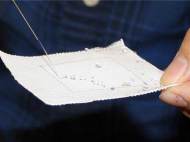Waterproof fabric that drains away sweat
 Workout enthusiasts, athletes and clothing manufacturers are all interested in fabrics that remove sweat and let the skin breathe. While cotton fibers and silk allow air to flow more freely, during heavy exercise cotton can get soaked, making it clingy and uncomfortable. Bioengineers at the University of California, Davis, have used new findings in microfluidics to develop waterproof fabrics able to whisk away sweat.
Workout enthusiasts, athletes and clothing manufacturers are all interested in fabrics that remove sweat and let the skin breathe. While cotton fibers and silk allow air to flow more freely, during heavy exercise cotton can get soaked, making it clingy and uncomfortable. Bioengineers at the University of California, Davis, have used new findings in microfluidics to develop waterproof fabrics able to whisk away sweat.
The new fabric works like human skin, forming excess sweat into droplets that drain away by themselves, said inventor Tingrui Pan, professor of biomedical engineering who leads the Micro-Nano Innovations Laboratory at UC Davis. One of the research areas of the Micro-Nano Innovations Laboratory is a field known as microfluidics, which focuses on making “lab on a chip” devices which employ tiny channels to manipulate fluids – a property suitable for applications like medical diagnostic tests.
Graduate students Siyuan Xing and Jia Jiang developed a new textile microfluidic platform using hydrophilic (water-attracting) threads stitched into a highly water-repellent fabric. They were able to create patterns of threads that absorb droplets of water from one side of the fabric, propel them along the threads and expel them from the other side.
The water-repellent properties of the surrounding fabric also help drive water down the channels. Unlike conventional fabrics, the water-pumping effect keeps working even when the water-conducting fibers are completely saturated, because of the sustaining pressure gradient generated by the surface tension of droplets.
The rest of the fabric stays completely dry and breathable. By adjusting the pattern of water-conducting fibers and how they are stitched on each side of the fabric, the researchers can control where sweat is collected and where it drains away on the outside. They also managed to achieve two operation modes – discrete and continuous transport.
“We intentionally did not use any fancy microfabrication techniques so it is compatible with the textile manufacturing process and very easy to scale up”, said Xing, lead graduate student on the project.
Aside being used by athletes, the novel interfacial transport on the textile platform developed by UC Davis researchers can be potentially extended to a variety of biofluidic collection and removal applications.
For more information, read the paper published in the journal Lab on a Chip: “Interfacial microfluidic transport on micropatterned superhydrophobic textile”.









Leave your response!